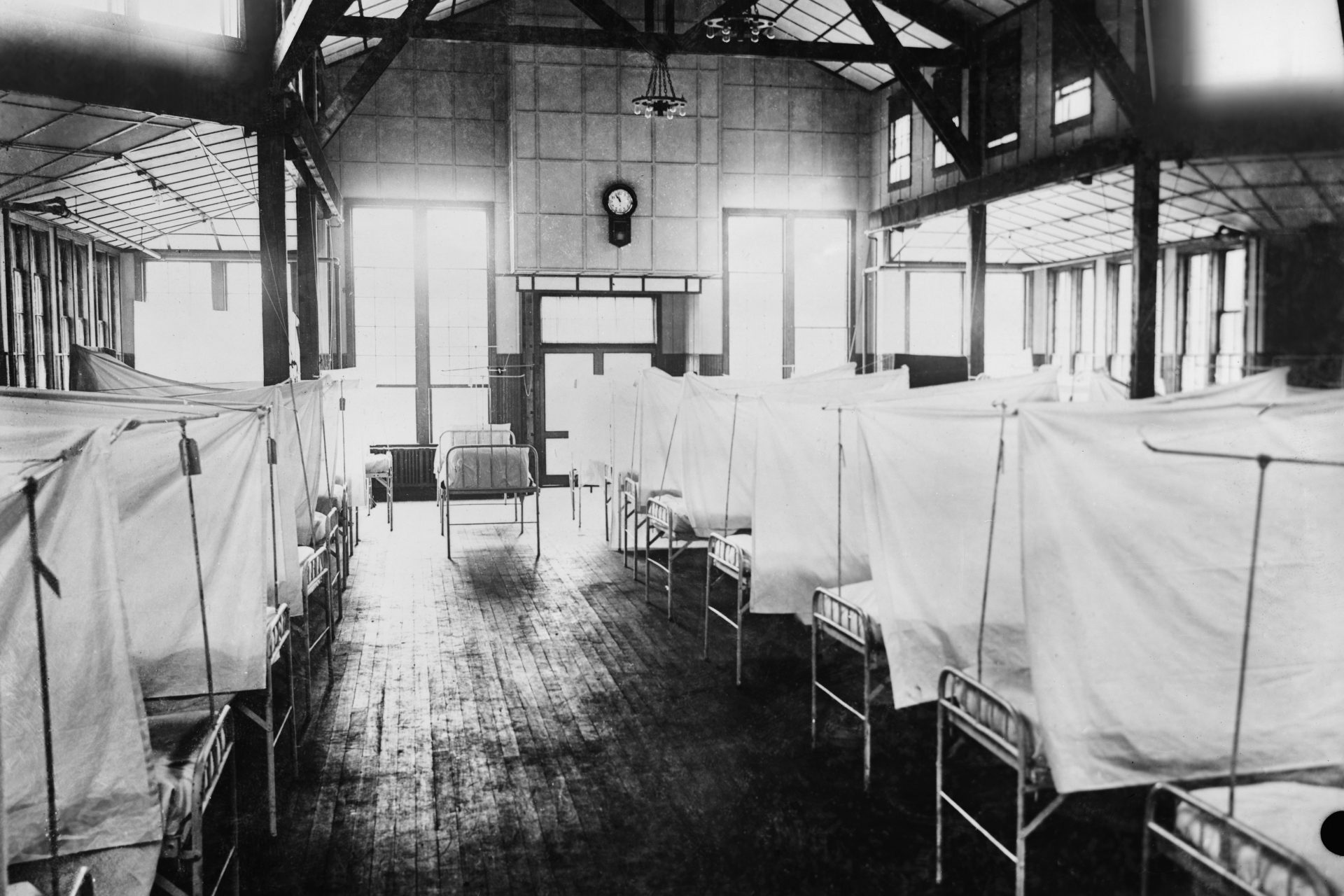The worst epidemics over the past 100 years
As we have seen, life changes radically when an unknown disease infects large groups of people. COVID-19 is just one of many such crises in our lifetime. In the past 100 years, we lived through about a dozen global pandemics and epidemic scares.
The coronavirus (COVID-19) is a type of human influenza. There have been other streams of this same illness. The Spanish flu, emerging in 1918, was one of the deadliest pandemics in recent history. It infected one-third of the world’s population and killed an estimated 50 to 100 million people.
First encountered in the American military camp Funston in Kansas (on this photo of the National Museum of Health and Medicine), it would reach the entire planet, up to remote Pacific and Antarctic communities, within 18 months. The virus caused 17 million deaths in India, 200,000 in the UK, and 675,000 in the US.
People called it the Spanish flu because war propagandists refused to publish the high numbers of casualties among First World War participants France, Germany, UK, and US, but they were free to write about Spanish deaths.
Different strands of influenza have different notations. The Spanish flu was H1N1. The so-called “Asian flu,” or H2N2, was detected in Guizhou, China in 1957. It first spread to Singapore and Hong Kong, then to the US and other nations. It caused 2 million deaths across the world, the WHO reported.
Ten years later, a modified strain of the Asian flu, H3N2, was detected in Hong Kong. This type also spread to other nations and killed about one million people worldwide.
Cholera is a bacterial disease that spreads through contaminated water. This pandemic started in Indonesia and spread to Bangladesh, India, and the Soviet Union in the mid-1960s before reaching South and Central America and Africa in later years. The death toll was approximately 200,000, but it has continued to grow with new cases and outbreaks in different continents.
Causing more than 30 million casualties so far, HIV is a bloodborne infection contracted by sexual intercourse or blood contact. HIV originated in the Congo Basin, Africa. In the 1960s, it spread to the US via Haiti (according to a study from the University of Arizona). Human Immunodeficiency Virus can evolve into AIDS (Acquired Immune Deficiency Syndrome), which can be deadly if not treated with (recently developed) anti-infection medication.
In the 1980s, Western media often connected HIV to homosexual men, as the epidemic was particularly acute in the UK and US gay communities. The disease does not discriminate, however, and makes victims anywhere. Singer Freddie Mercury (who died in 1991), actor Charlie Sheen, and basketball player Earvin ‘Magic’ Johnson are well-known celebrities infected with HIV.
The HIV pandemic continues to plague the world and affects both adults and (unborn) children. In Southern and Eastern Africa, infection rates can be as high as 25%, the WHO reports. The UN estimates that the AIDS death toll in African countries may reach 90 million by 2025.
Creutzfeldt-Jacob's disease (vCJD) is rare, but it caused a scare at the turn of the century in Western Europe and North America. The illness with a connection to the 'mad cow' disease (BSE) outbreak in 1999-2001, causes brain damage, pains, and psychiatric problems. The epidemic involved 129 infections, the WHO claims, especially in the UK and France.
SARS, short for Severe Acute Respiratory Syndrome, is caused by a coronavirus, SARS-CoV. It was contained as an epidemic in 2003, but a new outbreak remains possible. In 2012 another stream of the coronavirus appeared in Saudi Arabia: the Middle East Respiratory Syndrome (MERS). Both viruses can cause life-threatening infections in the respiratory tract. MERS cost the lives of about 500 people.
SARS was discovered in 2003 as a strongly contagious disease by the Italian physician Carlo Urbani. He got infected and died from the virus himself. The epidemic of SARS did not become a pandemic thanks to quick and thorough interventions by the WHO and local authorities. Around 350 people died of the disease.
After the SARS scare, the WHO established an official, international warning protocol for any epidemic that might become a pandemic: the Public Health Emergency of Public Concern. Its first declaration of an emergency came with the 2009 pandemic of the Swine Flu. This disease, H1N1, was related to the Spanish flu and made over 200,000 casualties.
The H7N9-type of influenza, normally found in birds, was first detected in humans in 2013. Around 1,500 people were infected, the WHO reports, and over 600 have died. Since the disease remained limited to China and did not appear strongly contagious, the WHO did not send out a pandemic warning.
Polio is spread by contaminated water and can cause paralysis. The illness seemed to have been eradicated from the world in the 20th century, but in 2014, cases of wild (not-vaccine-induced) polio occurred in Afghanistan and Pakistan. The WHO made an emergency declaration about polio that continued into 2020.
Ebola is spread through blood and other bodily fluids. The West African Ebola virus epidemic of 2013 struck Liberia, Guinea, and Sierra Leone. The WHO declared an international emergency in 2014 when a few cases occurred in the US and Europe. Homes were quarantined, like this one in Port Loko, Sierra Leone, to prevent the virus from spreading.
The Zika virus is carried by mosquitos. Originating in Brazil, it caused an epidemic of Zika fever in the Americas that infected more than 1.5 million people. The WHO warned that Zika could become a worldwide pandemic if the outbreak was not controlled. Cities like Rio de Janeiro, capital of the 2016 Olympic Games, desinfected their streets to fight the mosquitos.
The virus is especially harmful for unborn babies. When their pregnant mothers have the virus, they can get microcephaly, a defect in the development of their heads and brains.
In 2018, there was another ebola outbreak in the African continent. This time its origins lay in the North Kivu region of the Democratic Republic of Congo. The UN Dispatch argued that it was a "regional emergency, and by no means a global threat." When the disease spread to neighbouring Uganda in 2019 and had made about 1,500 casualties, the WHO sent out a warning for a public health emergency.
The COVID-19 pandemic has an established starting point in the Chinese city of Wuhan in the last month(s) of 2019. From there, it spread around the world which lead to lockdowns until enough people could be vaccinated. Casualties have run to 7,010,681 so far from the coronavirus COVID-19 outbreak as of April 13, worldwide, according to the World Health Organization.
More for you
Top Stories


































